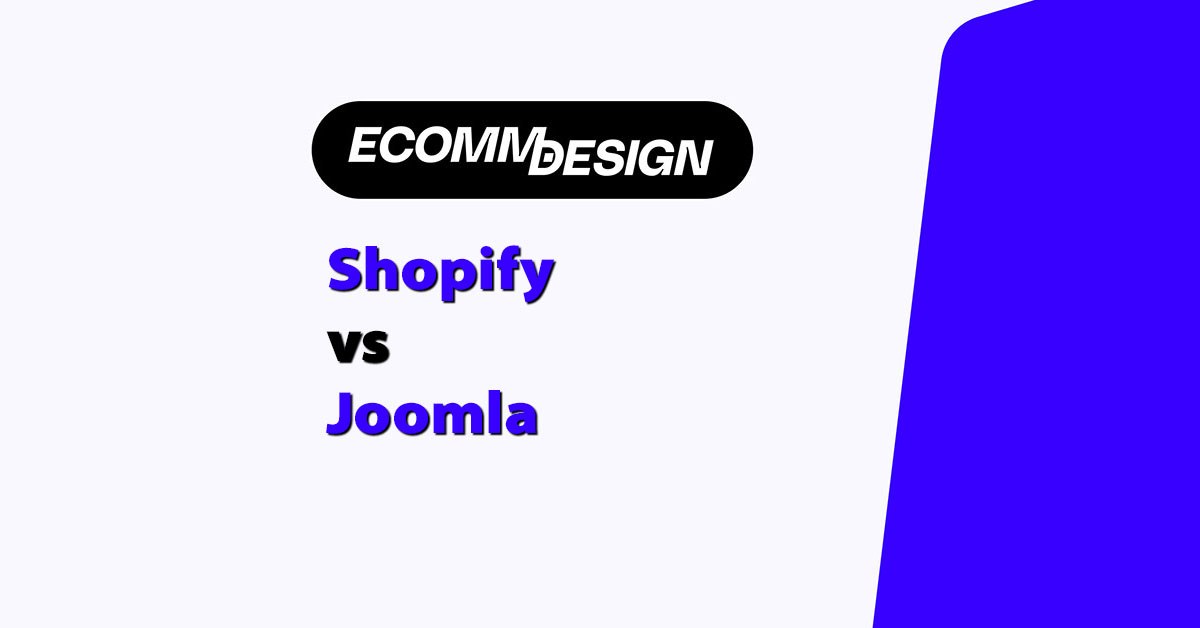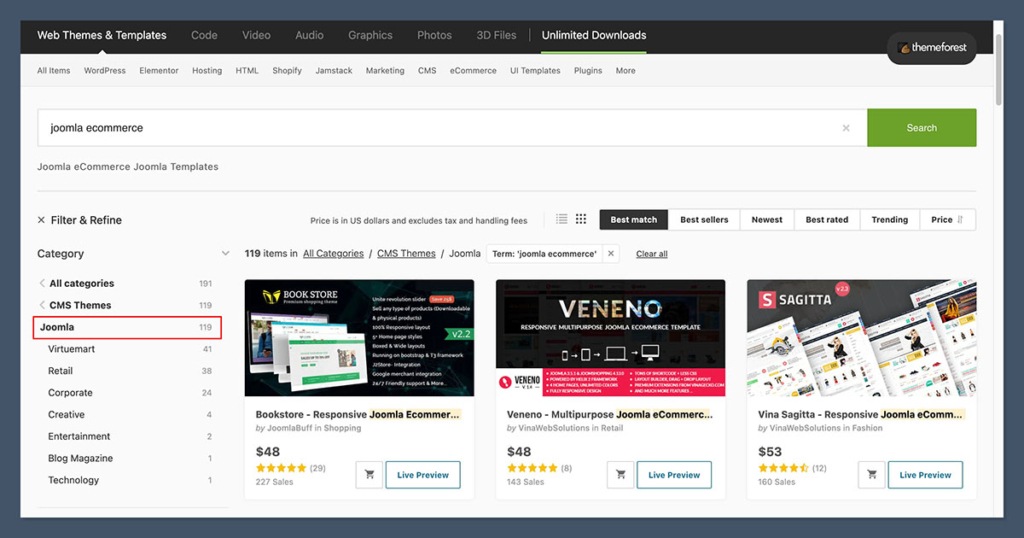
Shopify and Joomla are two very different platforms — one built specifically for ecommerce, the other built for flexibility.
But if your goal is to sell online, which one actually gives you the best tools to run a successful store?
I’ve spent hours comparing both platforms — from their pricing to their design features to how easy they are to use day-to-day.
After testing both platforms for ecommerce setups, Shopify is the clear winner for most online sellers. But Joomla has a few surprises too, especially if you’re more technical or want full control.
Let’s walk through what I found.
Shopify vs Joomla: Quick Verdict
Shopify – Best for ecommerce-first businesses and beginners who want a powerful store, fast
Joomla – Best for developers or businesses needing total design control and flexibility
In this review, I’ll break down how Shopify and Joomla compare in key areas like ecommerce features, ease of use, pricing, design, SEO, and support.
Quick Comparison: Shopify vs Joomla
Here’s a quick side-by-side overview:
| Feature | Shopify | Joomla |
|---|---|---|
| Best for | Beginners, growing ecommerce stores | Developers, custom CMS builds |
| Pricing | Starts at $39/month | Free (but hosting & setup costs apply) |
| Ecommerce-ready | Built-in | Requires extensions |
| Templates | 190+ modern themes | Fewer themes, but highly customizable |
| Ease of use | Drag-and-drop builder | Requires backend knowledge |
| SEO | Great out of the box | Needs setup and extensions |
| Hosting included | Yes | No |
| Support | 24/7 chat and help docs | Community-based, limited live support |
Best for Selling Online: Shopify

If your main goal is selling products online, Shopify is the better platform — and it’s not close.
Everything about Shopify is designed to help you run and grow an ecommerce store from day one.
Shopify’s Sales Features
Shopify has every core ecommerce feature baked in:
- One-page checkout
- Inventory management
- Product variants and SKUs
- Abandoned cart recovery
- Discount codes and gift cards
- Shopify Payments (native gateway)
- Real-time shipping quotes
- International selling features
You can also sell across multiple channels — Amazon, Instagram, TikTok, Facebook, and more — right from your Shopify dashboard. Shopify also supports point-of-sale (POS) tools if you run a physical shop.
For ecommerce growth, Shopify is unmatched.
Joomla’s Sales Features
Joomla wasn’t built for ecommerce — it’s a content management system first. To sell online, you’ll need to add a third-party extension like:
- VirtueMart (most common)
- J2Store
- HikaShop
- Phoca Cart
These add ecommerce functionality, but none of them match Shopify in terms of user experience or built-in power.
Things like cart abandonment, payment processing, or multichannel selling require additional setup, and in many cases, coding knowledge or hiring a developer.
The Winner: Shopify
Shopify gives you a full ecommerce toolkit from day one. Joomla takes longer to set up and is less optimized for modern online selling.
Best for Pricing: Joomla (Technically), but Shopify Offers More Value

At first glance, Joomla looks cheaper — it’s open-source and free to use. But the true cost depends on what kind of store you’re building.
Shopify Pricing
Shopify has three main plans:
| Plan | Price (Monthly) | Transaction Fees (w/o Shopify Payments) |
|---|---|---|
| Basic | $39 | 2.9% + $0.30 |
| Shopify | $105 | 2.6% + $0.30 |
| Advanced | $399 | 2.4% + $0.30 |
Other costs:
- Themes: Free or $140–$180 (one-time)
- Apps: Some free, others from $10–$100/month
- Add-ons like Shopify POS and Markets Pro can add more fees
Shopify also offers a 3-day free trial, and they often run promos (like 3 months for $1/month).
Joomla Pricing
Joomla itself is free. But here’s what you’ll likely pay:
| Item | Estimated Cost |
|---|---|
| Hosting | $5–$25/month |
| Domain | $10–$20/year |
| SSL | Often free via hosting |
| Ecommerce extension | Free or paid (some features are premium) |
| Developer support | $30–$150/hour (if needed) |
Over time, Joomla can be cheaper, but setup and maintenance costs — especially for ecommerce — can rise quickly.
The Winner: Joomla (if you have technical skill)
For pure pricing, Joomla wins. But Shopify delivers better value for most ecommerce store owners because everything’s built in and easy to manage.
Best for Ease of Use: Shopify
When I tested both platforms, the difference in ease of use was night and day.
Shopify’s User Experience
Shopify is made for non-technical users. The dashboard is clean, the onboarding is quick, and you get a 13-step setup guide to launch your store.
Features like product creation, payment setup, and theme customization are simple to access.
What stood out:
- Clean, modern dashboard
- No coding needed to launch
- Fast theme customization
- Everything feels unified
You don’t need to know HTML or CSS — unless you want to dive deeper into customization using the Liquid language.
Joomla’s Learning Curve
Joomla is built for flexibility, not simplicity.
The interface is powerful but outdated compared to Shopify’s modern builder. Extensions are needed for most ecommerce tasks, and you’ll often need to configure settings manually.
Setup involves:
- Installing Joomla on a server
- Adding ecommerce plugins
- Configuring multiple modules
- Customizing templates via code
If you’re tech-savvy or working with a dev team, this isn’t a dealbreaker. But for the average business owner, it’s a big roadblock.
The Winner: Shopify
Shopify is easier to use, faster to set up, and doesn’t require developer support for basic store features.
Best for Templates and Design: Shopify
Design is critical for trust and conversions. Both platforms offer theme customization, but Shopify’s modern theme library and editor make it the better option for most businesses.
Shopify Templates

Shopify has over 190 templates — 13 free and 200+ premium themes — covering industries like fashion, food, tech, and more.
What I liked:
- All themes are mobile-optimized
- Built-in UX best practices
- Filters for industry and features
- Easy-to-use section-based editor
Premium themes cost between $140–$180, one-time.
Joomla Templates

Joomla templates are mostly third-party.
While you’ll find some free options, the quality and support vary widely. You can use template frameworks like Gantry or Helix, but customization often requires HTML/CSS.
Pros:
- Full control over design
- Wide variety of niche templates
Cons:
- More technical work required
- Fewer ecommerce-focused templates
- Compatibility issues with extensions
The Winner: Shopify
Shopify offers a better overall design experience with clean, conversion-optimized themes and a user-friendly visual editor.
Best for SEO: Tie (But Shopify Wins for Beginners)
Both platforms can rank well in Google with the right setup. But Shopify makes SEO easier for beginners, while Joomla allows more technical control.
Shopify’s SEO Features
Shopify includes:
- Editable meta titles and descriptions
- Auto-generated sitemaps
- Mobile-optimized themes
- Canonical tags
- Integrated blogging
Shopify does have fixed URL paths (/products/, /collections/), which can be limiting for some SEO pros. But for most stores, the SEO tools are more than enough.
Joomla’s SEO Capabilities
With the right configuration, Joomla can be just as powerful — sometimes more so.
You’ll need to:
- Install SEO extensions like sh404SEF
- Manually configure URL structure
- Optimize page load times via server setup
- Enable caching and compression
For advanced SEOs, Joomla offers total control. But it’s not beginner-friendly.
The Winner: Shopify (for ease)
Joomla can match Shopify for SEO power, but you need to know what you’re doing or hire someone who does.
Best for Support: Shopify
If you get stuck on Shopify, you can get help right away. With Joomla, you’re mostly on your own.
Shopify Support
- 24/7 live chat and email
- Help center with tutorials and guides
- Community forums
- Phone support on Shopify Plus plans
Joomla Support
- Community forums
- Documentation guides
- Support from extension developers (if you use paid plugins)
If you run into issues on Joomla, you’ll need to rely on community support or pay for professional help.
The Winner: Shopify
Round-the-clock support makes Shopify the safer choice for most businesses, especially if you’re not technical.
Final Verdict: Shopify vs Joomla
Both platforms have their strengths, but for ecommerce, Shopify is the clear winner for most business owners.
Here’s the final scorecard:
| Category | Winner |
|---|---|
| Selling online | Shopify |
| Pricing | Joomla |
| Ease of use | Shopify |
| Design | Shopify |
| SEO | Tie |
| Support | Shopify |
If you’re launching or scaling an ecommerce business and want a clean, reliable platform with built-in features, Shopify is the better investment.
It saves you time, effort, and potentially thousands in development costs.
Joomla is great for developers and businesses that need full design or system control.
But it’s not built for ecommerce-first workflows — and that becomes clear quickly.
Recommendation:
Try Shopify’s free trial and test it for yourself. If you need more control and have the technical skill, Joomla is still a viable alternative — but it’s not beginner-friendly.






